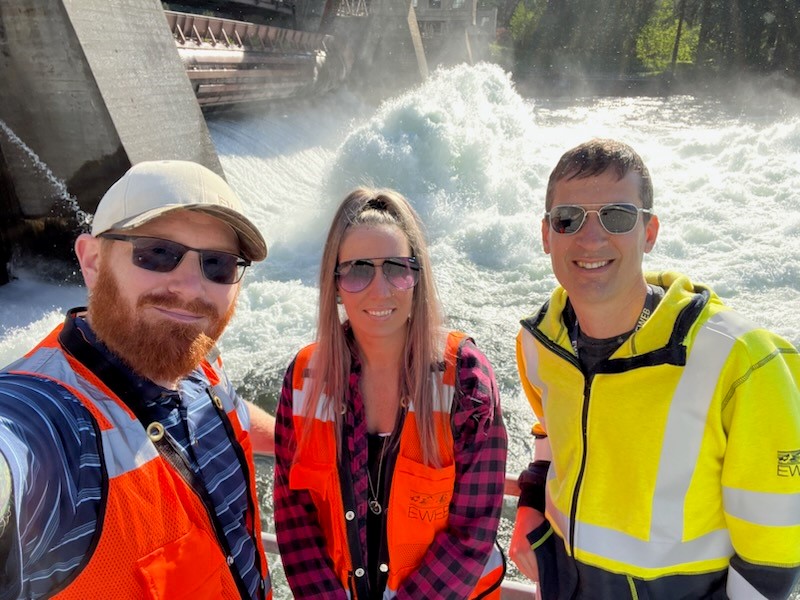Safety embedded in every aspect of EWEB's work
December 25, 2023 • Aaron Orlowski and Robyn Smith, EWEB Communications

This article was originally published in NWWPA's Nov. 2023 Bulletin.
At EWEB, safety is embedded in every action. Organizationally, EWEB's first core value is safety, followed by other crucial values of reliability, affordability, environmental responsibility, and community/culture.
“For EWEB, we apply our core value of safety to both the community and our workforce,” said EWEB Safety Program Manager Lance Hughes. “Our safety program succeeds because we have strong support from the utility’s leadership and across all levels of the organization.”
Over the past 20 years, a key safety metric — days away, restricted, or transferred (DART) — has trended steadily downward, with better and better results. In 2003, EWEB’s DART rate was around five for the whole utility, which includes both electric and water. In 2022, the DART rate was less than one — the lowest in the past two decades.

“We continuously strive to improve our safety program by reducing accidents and incidents and helping to create a safe environment for staff to perform work,” Hughes said.
Safety from the beginning
Safety is not a recent focus for EWEB, and in fact is foundational to the utility’s origin story. EWEB’s water utility was originally formed after an outbreak of typhoid fever in 1906 that was traced back to poor operating conditions at the privately owned water utility. The electric utility was formed soon after to provide electricity for treating and moving water.
“If the water and electricity we deliver isn’t safe and reliable, our community suffers,” Hughes said. “That’s why we focus so much on the practices and programs that contribute to safety.”
The safety program is multifaceted and oriented toward creating a culture of safety.
EWEB diligently tracks and reports metrics to identify where the utility is doing well and where it is lagging. The safety program goes beyond regulatory requirements to report near misses, which allows employees to identify learning opportunities. The utility supports physical and psychological safety, creating a culture of engagement and trust by incorporating concepts of overall health and wellbeing.
“None of these approaches to safety is fundamentally unique or new, but the approaches and resources available to pursue safety at every utility will vary, making each utility’s safety program inherently different,” Hughes said.
EWEB’s safety program strives to reframe discussions about safety protocols to drive employee engagement — a key factor in a successful safety program. Rather than dwelling on regulatory requirements, EWEB’s safety team focuses on teaching employees about the health and wellness implications of safety choices.
For instance, in a workspace with noisy equipment over 100 decibels, a safety manager could train employees to wear ear protection by simply talking about the regulatory requirement to do so. Or a safety manager could teach employees about the hazards of loud noises and how they can damage hearing, while also educating about the requirements.
“This kind of educational approach helps employees leverage the knowledge in their personal lives as well, which ultimately helps improve the overall health and wellbeing of our workforce,” Hughes said. “People want to work for an employer that values their safety, health, and wellbeing. This ultimately translates into better recruitment and retention.”
Building new infrastructure with safety in mind
EWEB places a high priority on the physical and psychological wellness of the utility’s workforce and the public, the security and integrity of cyber assets and data, and the protection of customers’ assets.
The safety of the workforce and community fundamentally drives how EWEB approaches strategic planning and projects to deliver essential utility services. This includes prioritizing safety on a new 10-year capital improvement plan for major infrastructure projects that EWEB has undertaken despite supply chain restraints that utilities across the region are facing. The plan calls for rehabilitating and replacing infrastructure to ensure the utility can meet the current and future electrical needs of the community safely and reliably. The plan includes a $125 million effort to rebuild 10 substations in 10 years.
“EWEB is always searching for the balance between the obligations we have to serve customers today and in the future. The objectives of this plan, spread over the next 10 years, is a great example of our service to both,” said EWEB Electric Operations Manager Tyler Nice.
From the 1950s to the 1970s, Eugene was growing fast as new residents and industries moved to the area. To keep
up with growing demand for electricity, EWEB went through a building boom of electric infrastructure. The equipment installed during that time makes up most of the equipment in EWEB’s electrical grid today, but that infrastructure is reaching the end of its useful life and no longer meets modern safety expectations. Those expectations include seismic standards that are needed to help ensure infrastructure can survive major disas- ters, such as the Cascadia Subduction Zone earthquake.
Safety considerations into the future
Safety is incorporated into the design process for new infrastructure from the beginning, reducing future risk for years to come.
Recently, EWEB’s safety team joined discussions about the design of new water storage tanks in Eugene. The project design included a room accessed by a hatch and 10-foot ladder that EWEB staff would need to access frequently. The safety team discussed the hazards of repeatedly navigating that kind of layout and worked with design colleagues to reconfigure the space to a simple door access with stairs.
“This change will ultimately impact our workers hundreds or even thousands of times in the next 50 to 100 years,” Hughes said. “Though the change may cost more, it will be money and time well spent for the utility, creating a safer environment for future generations of EWEB staff.”
And this commitment to safety is something EWEB shares with other utilities.
“What I’ve seen is that all of us who work for utilities, especially in public power, have a shared passion for safety and we are very open with each other about how we succeed and when we fail,” Hughes said. “We are always seeking to learn from each other, and the networking opportunities offered by NWPPA and other trade organizations are invaluable for sharing skills and best practices.”

